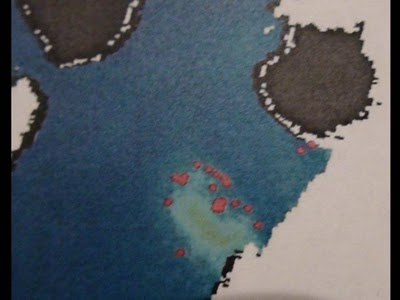During the last days, our remote sensing devices detected the development of a bloom south of Gran Canaria Island. In the satellite images below, the reader can observe the generation of the bloom in the four typical oceanographic phases. Because this season is not characterized by the presence of any bloom around the islands, we investigated its generation through specific algorithms performed in our labs. Applying the one obtained by Ramos et al. (2005), we found the presence of the cyanobacteria Trichodesmium spp (red dots in the images). Because of the high confidence of this algorithm, we are now sure that the bloom was generated artificially, probably by dumping tons of iron to the ocean. Therefore, we investigated the presence of any research vessel in the economic zone of the Canary Islands. No results were obtained and we asked our colleagues at the University of Madeira. They reported the presence of the new research vessel of the new american company Plantox during November. This company is pursuing the drawdown of carbon dioxide using iron fertilization in order to earn carbon credits through the Kyoto protocol. However, this procedure is rather controversial because of the unknown toxic effects in the marine environment. In fact, the International Committee for the Law of the Sea based in London has dictated the prohibition of those procedures. The detection of cyanobacteria using remote sensing procedures alert us about one of these effects. As it is known, this bacteria can produce toxic substances affecting fishes and humans. The fact that fertilization took place quite near of Gran Canaria Island alert us about their effect of our coastal zone. This problem is even worst due to the important turistic area located south of this island.
 Phase I of the bloom south of Gran Canaria Island. Observe the formation of the phytoplankton outburst (in green) and the formation of cyanobacteria (red dots). Areas in white are clouds formed during the last weeks due to an important low crossing the islands from southwest to northeast.
Phase I of the bloom south of Gran Canaria Island. Observe the formation of the phytoplankton outburst (in green) and the formation of cyanobacteria (red dots). Areas in white are clouds formed during the last weeks due to an important low crossing the islands from southwest to northeast.  Phase II of the bloom. Observe the increase in phytoplankton (green) and the growth of cyanobacteria at the boundaries of the forming bloom (red). Areas in white are clouds.
Phase II of the bloom. Observe the increase in phytoplankton (green) and the growth of cyanobacteria at the boundaries of the forming bloom (red). Areas in white are clouds. Phase III of the bloom. The area of the phytoplankton bloom is approaching the size of Gran Canaria Island. The cyanobacteria remained at the edge of the bloom.
Phase III of the bloom. The area of the phytoplankton bloom is approaching the size of Gran Canaria Island. The cyanobacteria remained at the edge of the bloom.
 Phase IV. Observe the impressive size of the phytoplankton outburst and the generation of cyanobacteria at the boundaries of the bloom. Right now, our concern is the proximity of the bloom and cyanobacteria to the south of Gran Canaria during the last hours.
Phase IV. Observe the impressive size of the phytoplankton outburst and the generation of cyanobacteria at the boundaries of the bloom. Right now, our concern is the proximity of the bloom and cyanobacteria to the south of Gran Canaria during the last hours.
1 comment:
Post a Comment